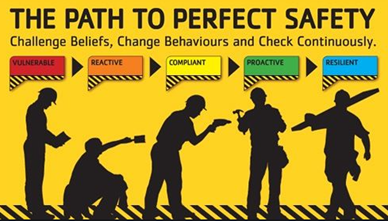Originally posted on June 15, 2021 @ 2:36 PM
Methodology and an Ethic of Risk

If one experiences brutalism in the delivery (method) of safety, the question should not be about the method but rather what drives the method. What kind of ideology sanctions and motivates this method? That should be the question? What kind of ethic considers violence toward another as a valid way of obtaining zero? What binary ideology condones duplicitous language just so it can get an outcome? We see this duplicitous language threaded throughout all the discourse on zero.
When we look at a semiotic image we similarly see (envision) the outcome of a driving philosophy. The semiotics of objects in safety emerges out of an ideology that believes safety is about objects that control other objects. The development of hierarchical and linear models of prevention and control emerge out of a philosophy that imagines the world as a reductive ordered process. The last thing one wants to confess in zero is that there is disorder in the world and uncertainty in the world and humans don’t have the power to control everything. Sometimes bad things happen to good people (https://oiipdf.com/download/26628) as discussed by Harold Kushner. Whilst some like to imagine that all can be controlled we know psychologically that such imagination is a mental health disorder. Delusional imagination is a significant factor in mental health. Losing touch with reality is psychologically harmful. Such is the delusion of perfection in Zero.
When we look at the video Spirit of Zero (https://safetyrisk.net/the-spirit-of-zero/) we are looking at the outcome of a methodology. The method simply shows a fictional zero healing the injured, restoring limbs and healing the harmed. The ideology that sanctions such a video is the real concern. Using supernatural semiotics (https://safetyrisk.net/a-semiotic-map-for-safety/) to connect to a method in safety is an even greater concern. Then washing any responsibility or attachment to such a methodology with ‘I don’t really believe that’ is just more duplicitous unethical double-speak that cements in place an even greater delusion and denial.
Such duplicity is unethical but is common to all those who want ‘a bet each way’ on zero. As we watch associations disown the rhetoric and semiotics of zero but being signed up to zero in association we see even greater duplicity. This shows up in statements like ‘’I’m agnostic about zero’. Even passive acceptance of zero or denial of zero semiotics is an endorsement of Zero and all that goes with it and the methods that emerge from its semiotic power.
If you want to get away from zero (https://safetyrisk.net/moving-away-from-zero-so-that-safety-improves/ ) then the first thing that must go is the semiotics of zero. Second is the language of zero. Third, the numerics of zero and finally the discourse (philosophy) of zero.
The toughest thing to move in the rejection of zero is not the slogans of zero like ‘safety is a choice you make’ and ‘all accidents are preventable’ or the semiotics of zero but the binary methodology at the foundation of zero that cannot handle the fact that humans are fallible (https://www.humandymensions.com/product/fallibility-risk-living-uncertainty/ ). Whenever Zero seeks commitment and ‘belief’ this is what it seeks, the denial of fallibility and the belief in infallibility, that is the methodology of zero.



Do you have any thoughts? Please share them below